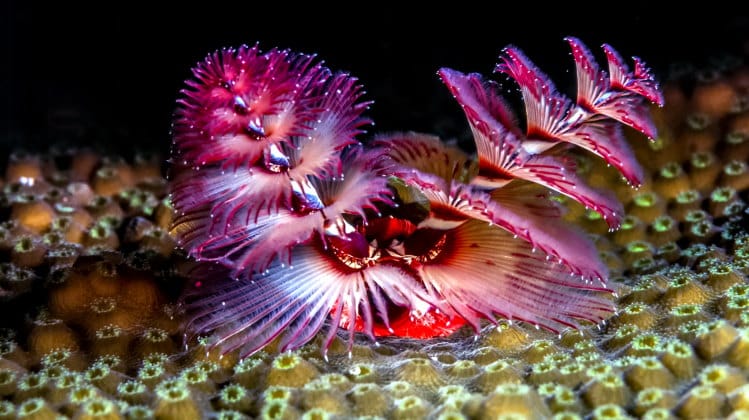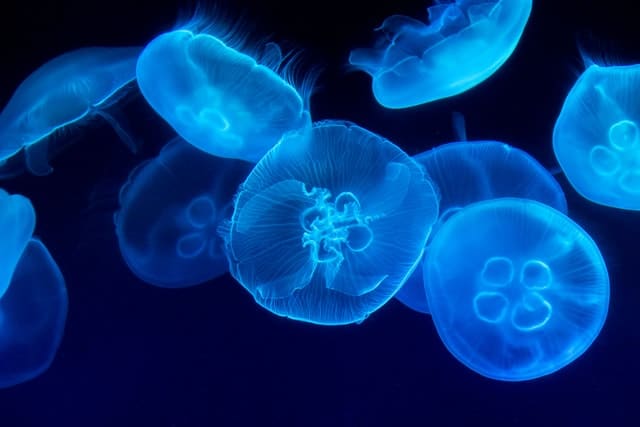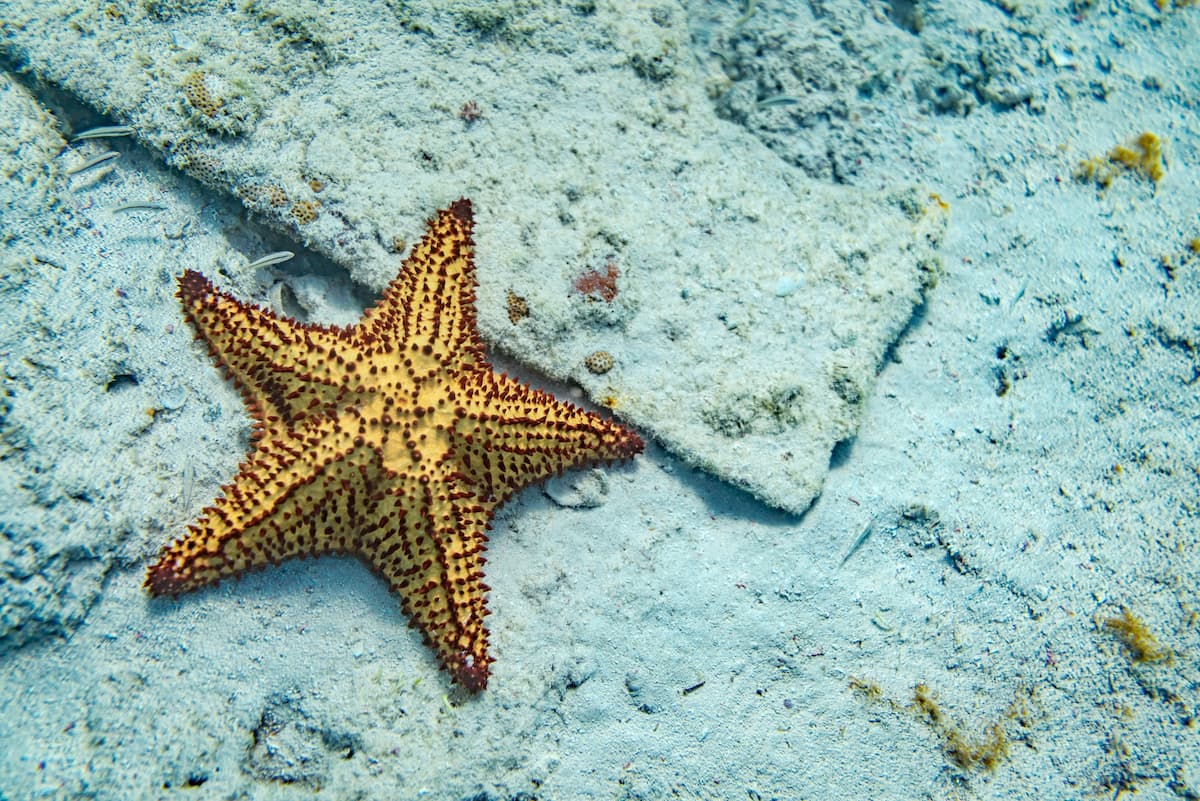The Polychaeta: Worms, Worms and More Worms
The Polychaeta is the largest and the most diverse of the Annelid groups.
Most species are marine, but some have adapted to brackish or even fresh water and a very few are terrestrial.
More than 10,000 species are known to science. They are by far the most attractive of the annelids and in many cases are very beautiful.
Most species are long and thin with bodies built up of a series of identical segments. At the front is a prostomium and sometimes a peristomium, that make up the head. At the other end is a pygidium, the anterior section which is the area of new growth where new segments are formed.
However not all Polychaeta species conform to this basic plan and there are short and squat species which are covered with hair or scales and which look nothing like a worm at all. The Sea Mouse Aphrodite aculeata is a good example of this.
Introduction
About half the known polychaeta are free living predators or scavengers – and the other half live permanently in burrows.
This has resulted in the polychaeta being divided into two ecological groups:
- the active forms that move around searching for food (called the Errantia)
- those that live in burrows (called the Sedentaria).
I must stress however that these are not taxonomically valid groupings and are useful only for linking groups with ecologically behavioural similarities.

In most polychaetes – particularly the errant forms – the head is well developed, having eyes and sensory tentacles as well as the mouth. The mouth includes chitinous jaws and an evertable pharynx (evertable means capable of being extended outwards).
In many of the sedentary forms however, the eyes, structure of the jaws and sensory equipment are reduced or absent. The difference in these two lifestyles is also reflected in the nervous system, which is much better developed in the errant forms than in the sedentary ones.
Furthermore, the active forms all have well developed lateral (side) appendages.
These appendages are not really legs, though they are limb-like; they are called parapodia. Parapodia contain their own muscles, nerves and chaetae. They have various uses, but in the errantia are predominantly organs of locomotion.
In the sedentary forms forms these parapodia are often greatly reduced or absent. However the sedentary forms often have from a few to many tentacles associated with the head of the animal that help in collecting food. In some forms, the parapodia of the first 1 or 2 segments may be transformed into cirri – long thin appendages like antennae or tentacles.
The Polychaeta Nervous System
The nervous system consists of a brain, which is found in the prostomium and connected to the ventral nerve cord and the sub-pharyngeal ganglia by a special set of nerves called the circum-pharyngeal connectives.
The ventral nerve cord is surrounded by a fibrous sheath. This sheath also acts as an anchor for the muscles that move the parapodia. The nerve cord contains two sorts of nerve fibres; normal nerve and giant nerves.
The giant nerves are only important during rapid escape manoeuvres, when the animal needs to react very quickly.
The ventral nerve cord runs the whole length of the animal and gives rise to several sets of nerves in each segment.
In the more active errant forms each segment has its own small ganglia, but in the more sedentary forms these are absent. Also, the more active the lifestyle of an animal the larger its brain, because of the need to interpret a much greater input of sensory information as well as the need to co-ordinate more varied and complicated movements.
Blood and Circulation in The Polychaeta
The blood system is a closed system, meaning that they have blood vessels through which the blood flows. There are two main longitudinal blood vessels, a dorsal one and a ventral one. These vessels have circular muscles around them which can contract rhythmically to keep the blood moving around the body.
Blood flows from the head to the tail in the ventral vessel and back, from the tail to the head, in the dorsal vessel. In each segment a number of smaller lateral (side) vessels branch off from the main vessels to supply the sections of that segment.
The blood of annelids contains haemoglobin, the same respiratory pigment as in humans, it is this that makes their blood the same red colour as ours.
Gaseous Exchange
Gaseous exchange normally occurs over the whole of the animal’s body. In the errant forms, the parapodia are particularly well supplied with blood vessels and are important organs for gaseous exchange.
In many of the sedentary forms, the tentacles (when present) perform a similar function.
Other species have special external gills to increase the respiratory surface area, i.e. Arenicola marina. Many burrow dwelling species generate a water current through their tunnels, which not only assists in the capture of food but ensures them a constant supply of oxygenated water passing over their bodies.
Excretion and Osmoregulation
Excretion of metabolic wastes is through the action of nephridia.
These are long, coiled tubes which have many cilia lining their internal surface. Both blood and coelomic fluid enter these nephridia where nutrients, water and salts are removed, before the remaining wastes are passed out through the nephridiopore.
In the errant polychaetes (and the Oligochaetes) most body segments, except the first and last, have their own pair of nephridia. In sedentary Polychaetes, the number of nephridia may be reduced and in Arenicola marina they occur only on segments 4 to 9.
Nephridia also serve as organs of osmoregulation. In species that live in fresh water – or environments with variable salinity – such as Nereis sp., the nephridial tubes are longer to help them deal with the greater osmotic potential occurring between their inner body fluids and the fluids of the environment they are living in.
Reproduction and Diversity in The Polychata
Polychaeta Errant Forms
The Polychaeta exhibit a wide range of lifestyles.
Among the errant forms many are benthic, meaning they live primarily on the sea floor. Some of these, such as various members of the family Eunicidae and Syllidae, have the unusual habit of detaching the rear portion of their body as a special vehicle for reproduction.
Before this happens, all the organs except the reproductive ones degenerate in those segments which will be detached. Thus the posterior segments of the animal become little more than motile sacks of reproductive organs. When the time comes for the animals to reproduce (an event which is controlled by the season and the phase of the moon) the hind portions separate from the animal and swim to the surface, where they gather on mass and release their gametes into the sea. They then die.
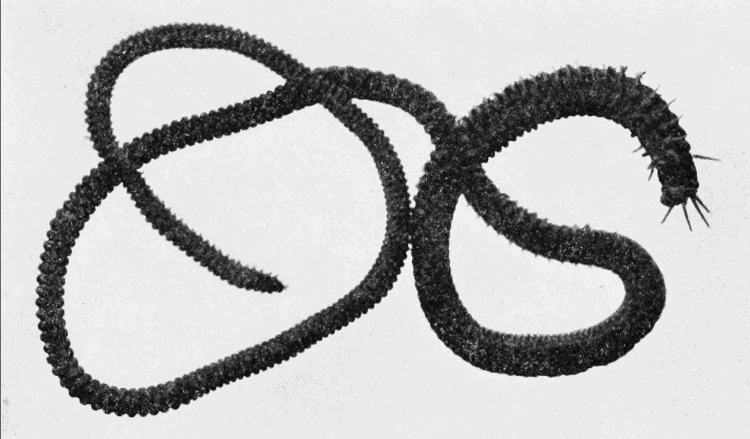
The common name for these species is Palolo Worm and they are greatly enjoyed by local fishermen who collect huge numbers of them to eat. This reproductive frenzy is well timed and occurs on the second or third day after the third quarter of the moon – in October and November for Eunice viridis, the Samoan Palolo Worm, and on the second or third day before the third quarter of the moon in Eunice fucata, the Atlantic Palolo Worm.
The Syllidae take this one evolutionary step further and the detached segments grow a new head, so that what rises to the surface is a new animal. This is an asexually reproduced generation that in turn reproduces sexually. Thus in this family, the Polychaeta undergo a sort of ‘alternation of generations’.
Family Nereidae (True Ragworm)
The family Nereidae are among the most commonly know Polychaetes, as they include the ragworm used by fishermen as bait in sea fishing and are bred commercially for this purpose.
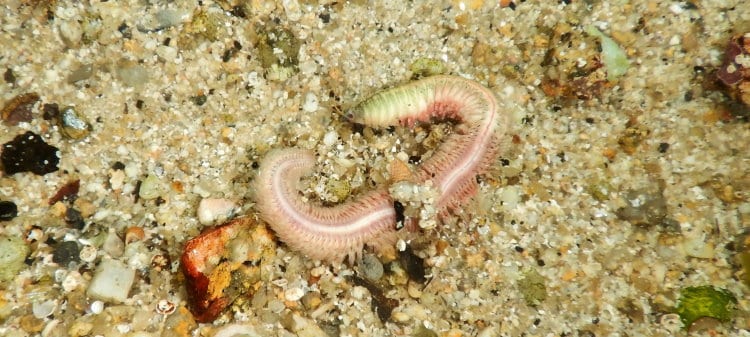
Nereids are characterized by long, thin multi-segmented bodies with well developed parapodia.
Some species are active hunters, while others feed on algae. As the breeding season approaches, members of the genus Nereis undergo changes to their parapodia. Then, when their gonads are mature, the animals swim to the surface where – like in the above case – the gametes are released into the water. The animals then dies.
Scientists give this form of reproduction the term ‘Epigamic epitoky’. It is the first step in the evolutionary move towards the production of an asexual generation, as seen in the Syllidae. When, as in the Eunicidae and the Syllidae, part of the animal separates off and carries the burden of the reproductive effort without the original animal dying, this is called Schizogamic epitoky.
In some species a slightly different route is taken, in that new individuals are budded off from the posterior segments of the adult. These sections slowly develop into new worms and finally separate off when they are ready to take up life as a free living individual, i.e. Autolyptus prolifer.
More than one bud – or stolon, as they should be called – can form from one animal, one behind the other.
Thus long chains of up to 20 newly forming animals have been observed in some specimens of Nereidae species in genera such as Myrianida.
Not all the errant polychaetes exhibit the slim line form of the previous three families. Members of the family Aphroditidae are often short, squat looking animals covered in modified hairs or scales. Aphrodite aculeata, often called the Sea Mouse, is barely twice as long as it is wide.
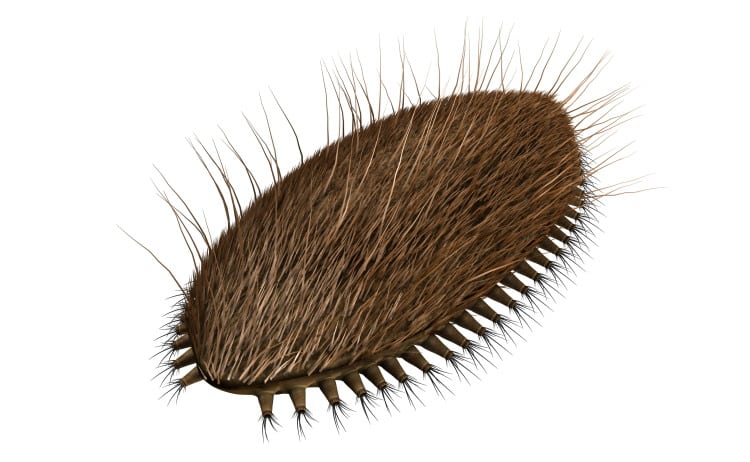
Furthermore, not all errant polychaetes are benthic.
Members of the family Phyllodocidae hide on the sea floor during the day but swim about in the open water hunting for food at night. Going a step further, members of the families Alciopidae and Tomopteridae have become completely planktonic – meaning they live near the surface of the sea.
Their parapodia have become modified for swimming, not crawling – and like many planktonic animals they have become practically colourless.
To help us appreciate the full diversity of the errant Polychaetes, we also need to know of some of the less common forms. In Sumatra can be found the genera Lycastopsis and Lycastis (from the family Nereidae). These two groups have moved to the very edges of the aquatic environment – and in some cases left it all together – and now live a damp, but terrestrial life in burrows in mud or rotten wood.
Very few species of Polychaetes have ventured into fresh water. Among the errant forms that have is Nereis limnicola, which can be found in fresh waters in California USA. Among the sedentary forms are several members of the family Sabellariidae, such as Dybowscella sp. from lake Biakal Russia and Manayankia speciosa from lake Erie USA.
Finally, it is worth mentioning that not all polychaetes live on their own. A number of errant polychaetes have become commensals with other organisms.
For instance, Nereis fucata lives in the shell of the Hermit Crab Eupagurus bernhardus. Arctonoe vittata lives with the Keyhole Limpet Diodora aspera and Arctonoe fragilis lives with the Starfish Erasterias traschelii.
Others, such as Polynoe scolopendrina have taken to living in the tubes of larger sedentary polychaetes.
Going one step further than this, some errant members of the polychaeta in the families Ichthyotomidae and Hristriobdellidae have become parasitic. The single member of the family Ichthyotomidae, Ichthyotomus sanguineus is a parasite on the gills of eels. Hristobdella homari is a parasite of lobsters and Stratiodrilus tasmanicus is a parasite of the Tasmanian Crayfish.
A few other errant families of the polychaeta possess a parasitic member or two. Thus at least one Oligognathus species (Family Eunicidae) is parasitic on the Echiuroid Bonellia sp. and Haematocleptes terebellides is a parasite of another polychaete, namely Terebellides stroemi. A number of other Eunicids have been found inside the bodies of other worms.
Sedenatry Forms of The Polychaeta
The sedentary polychaetes are a taxonomically diverse group.
As I have said before, this does not represent any cladistic or evolutionary relationship, but rather merely reflects the fact that most of them live in burrows lined with bodily secretions of some sort.
These tubes may be dug into the substrate (mud, sand etc.) or merely coated with a layer of sand, shell or calcium carbonate. In this latter case, the tubes are often attached to the surface of some object such as a rock, shell or frond of alga (seaweed). These tubes may be straight, U-shaped, coiled (in a left or right spiral) or irregularly twisted depending on species.
The sedentary polychaeta are not active hunters like their relatives the errant forms. Instead they fed on particles of organic matter filtered, or foraged from the sea and the vicinity of their burrows. Or else they eat the substrate they live in, digesting the micro-organisms that live there as well as any particles of organic matter they come across.
Thus the sedentary groups of the polychaeta can be roughly divided into three groups:
- filter feeders,
- searchers and
- substrate eaters.
Sedentary polychaetes normally have their body divided into two, or sometimes three, distinct sections or tagma. They usually have their secretory organs in the anterior, or front, section of their bodies. This allows them to direct their wastes towards the outside of their tube. Many species also have gills on some segments of their bodies.
The filter feeder and searching forms have a collection of tentacles, normally finer in the filter feeders, at the anterior end of their bodies. These tentacles arise from one or more of the various segments that make up the head region of the animal’s body. These tentacles often act as organs of gaseous exchange, as well as serving their role in the collection of food.
A well known example of a substrate eater is the common Bait or Lug-worm, scientifically known as Arenicola marina. Arenicola has much reduced, or virtually absent parapodia and looks more like an Oligochaete. On close inspection, it can be seen that it does have gills. It also has chaetae which it uses to grip the side of its burrow.
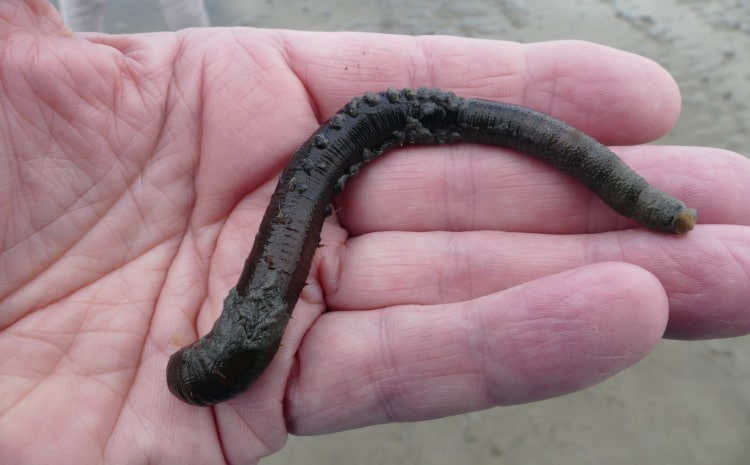
Unlike earthworms however, Arenicola can not crawl – and if removed from its burrow, it simply digs a new one where it is. It rests, head downwards, within its burrow with the posterior or tail end towards the one open end of the burrow. The other side of its burrow is constantly filled with loose sand, which it eats and excretes above and around the burrows opening.
Muscular pulses of the body draw a flow of water down over the worm’s gills and out through the sand filled end of the burrow. Any organic particles that enter with the water become trapped in the sand and are eaten by the worm. Like many substrate eaters, Arenicola follows a regular cycle of activity which results in it defecating a cleaned load of sand every 40 to 45 minutes.
Because organic, and therefore digestible, material makes up only 2 to 3.5 percent of Arenicola’s diet, it needs to eat large quantities of sand – and therefore produces a lot of sand waste. It is these piles of defecated sand around the open end of its burrow, that make Arenicola so easy for fishermen to find at low tide. Arenicola often lives in the intertidal zone of the shore. When the tide is out and there is therefore no flow of water to bring it oxygen, it rests in the bottom of its burrow.
An interesting and unusual filter feeder is Chaetopterus variopedatus.
Much like Arenicola, Chaetopterus lives in a U-shaped burrow in the shallow coastal waters of the Atlantic ocean and the Mediterranean sea. Its body is divided into 3 separate sections.
The first segment of the second section has modified parapodia that secrete a mucous bag. The 3rd 4th and 5th segments of this section also have modified parapodia. These beat rhythmically, creating a current of water through the animal’s tunnel. Organic particles in the water are trapped in the mucous bag secreted by the 2nd segment and subsequently digested when Chaetopterus eats the bag.
Chaetopterus has no gills, but respires across its whole body surface. Chaetopterus is also of interest because it is one of a number of polychaetes capable of producing light. Like most other organisms, including fish and insects, Chaetopterus does this with controlled colonies of bacteria – and it is the bacteria, living in the animal, that give off the light.
The light given off by Chaetopterus is a very pleasant blue. While I have read reports of animal radiating light from their whole body, the ones I have seen only gave off light from a small midsection of their body – and only then reluctantly.
Quite what chaetopterus does with its light, I have no idea.
Pectinaria koreni is a small, 5cm long worm that lives permanently within a burrow in seas with a sandy substrate. Lining the inside of the burrow, and extending some distance above the sea floor, is a tube of sand grains. The portion of its tube that is below the sea floor is much wider than the the section above the sea floor. Pectinaria spends its time sorting through the sand grains enclosed for food.
There are a number of species of Pectinaria worms in the world. Some of them are real craftsmen, aligning the grains of sand that they make their tubes from so that the inside of their tube is as smoothly tiled as a modern human bathroom wall.
Members of the genus Owenia are also known to carefully select and place the small fragments of shell they use to make their burrows – however in this case the result is more like a tiled roof.
More unusual are several species of Alophorus who build their tubes only from the spores of aquatic plants, such as Azolla and Salvinia.
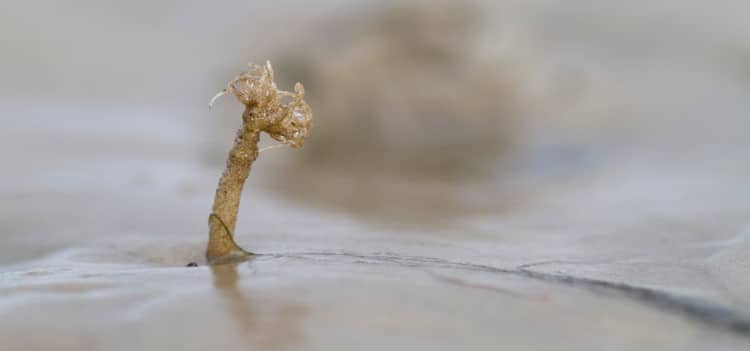
Lanice conchilega is another tube building worm. It is often called the “Sand Mason” in Europe because of the cleverness with which it builds itself a sand patio to its tube. It uses this patio to help it catch small organisms for its lunch. Members of the genus L. conchilega like to live close to each other and the result – when tens of thousands of animals all live side by side – is a living reef of cemented sand, that can be home to many other organisms.
L. conchilega is not the only worm to alter the sea floor in this way. Sabellaria spinulosa and Phragmatopoma sp. in tropical waters are both small worms which can build large reefs, up to one metre high and hundreds of metres long.
One such reef studied contained in excess of 75 million worms!
Not all tube building worms use particulate materials which they find near them. Many species in the family Serpulidae secrete calcareous, spiral or straight tubes. These tubes can be found on rocks, seaweed, large shells, and are often very numerous. They are mostly small worms measured in millimetres rather than centimetres and in many habitats, they are the most common of all the polychaetes present.
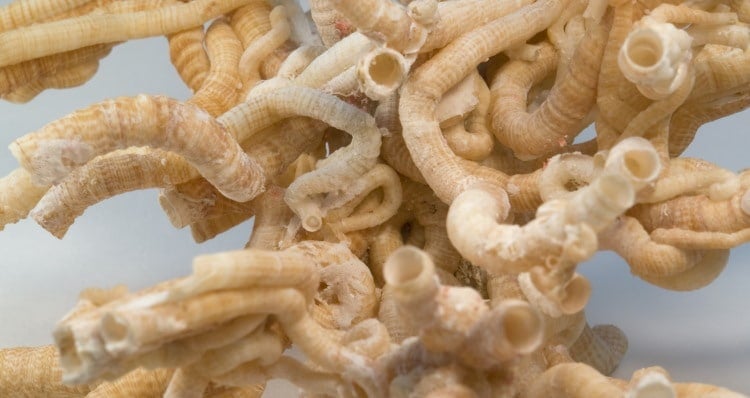
Within a given genus, there can be much variation in the structure and orientation of these tubes – which can often be important in identification.
Serpulids possess a crown of fine tentacles arising from the oral segment, which they use in filter feeding. Many species are very beautiful when they have their fans fully extended. However, they are quick to withdraw their tentacles back into their tube at the slightest sign of danger. Species in the genus Spirographis, such as Spirographis spallanzanii are well known for their beauty.
Finally, as nature loves to contain exceptions to the rules we humans try to impose on her, it is worth mentioning Fabricia sabella.
F. sabella is a small (less than 1 cm long) worm which normally lives in an equally small burrow and filter feeds with its crown of tentacles. However, unlike its relatives, it likes to go for a swim and seems quite happy wafting its way through the water, dragging its crown of tentacles behind it. It is also unusual in that it has two pairs of eyes, one pair at each end of its body.
Final Thoughts
The subphylum polychaeta now also includes the old phyla Echiura and Pogonophora
Well, I hope you have learned something about the wonders of Class Polychaeta!
Why not consider exploring the world of earthworms?
Earthworm image: License Creative Commons

